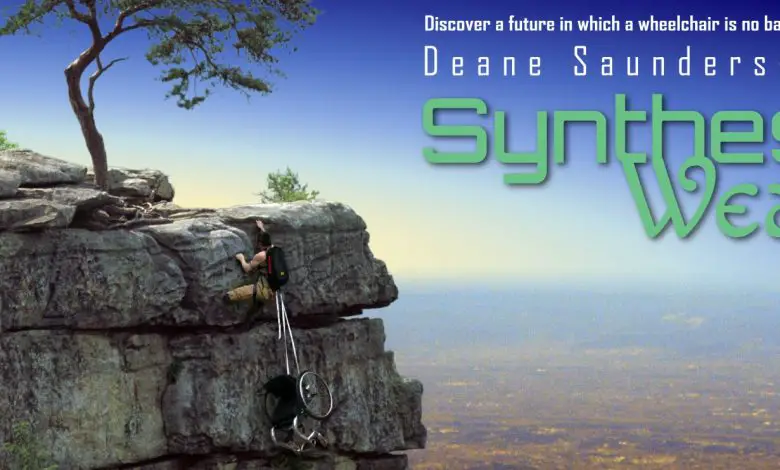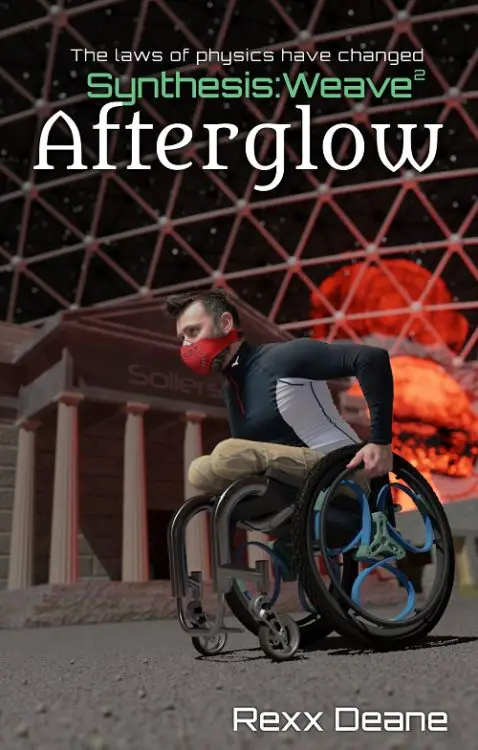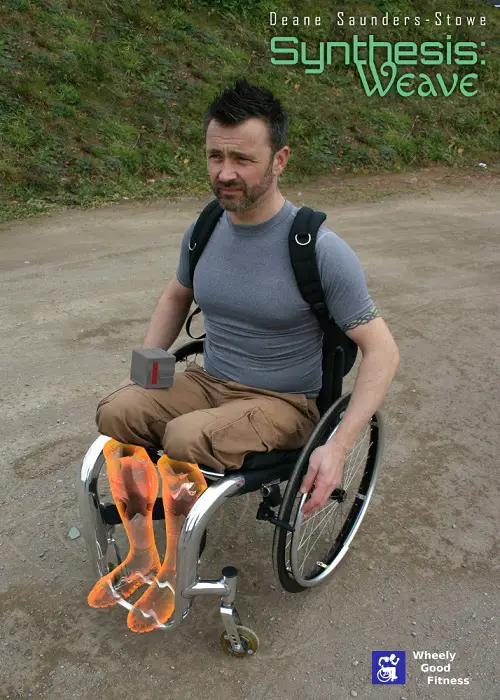
New sci-fi novel features a main character with a disability
One of the differences with Synthesis: Weave is that while it’s got a disabled protagonist it’s not a book about disability. The fact disability is there is just that, an incidental part of the character’s life. It causes some problems and plot twists, but it’s not the focus. Author Deane Saunders-Stowe tells us more about this new and unique sci-fi novel.
UPDATE March 2019: Dean has re-worked Synthesis: Weave and it has now been republished. The sequel, Synthesis: Weave 2, Afterglow, was published on 1st of March 2019 to coincide with International Wheelchair day.


My name is Deane Saunders-Stowe and I work as a web developer for a behavioural design company. I grew up in the Forest of Dean, Gloucestershire, but moved to Ross on Wye in Herefordshire when I met my partner Kris, who runs Wheely Good Fitness. It wasn’t until early in 2013 that I decided to write my first novel.
Not long after I moved to Herefordshire and started a new job, I drove past a sign for a place called Sollers Hope. I had never visited it, and the name suddenly evoked images of some kind of far-flung outpost in the back of beyond. I started imagining scenes of a mining colony on an asteroid in space. The same thing happened when I travelled through a place called Yazor.
A few weeks later, I was thinking about what might happen if magic were real and you could become invisible. I through about every detail, such as what would happen to the food you ate? Would that become invisible? I decided it wouldn’t, but your body would incorporate the visible molecules into its structure. Then, strange visions of a partially visible man started popping into my head. That’s when I thought that perhaps I should write a book with this as a character?
My partner, who is a wheelchair user and wants to have his knees amputated for numerous medical reasons, inspired me to think about another character for the book, and so I started coming up with ideas. The implications of it were enormous. Finally I had enough ideas to prompt me to begin writing.
A tsunami on a space station. An explosion with no trace of the bomber. Sebastian knows evidence doesn’t magically disappear, yet when he and disabled ex-marine Aryx travel the galaxy to find the cause, there seems to be no other explanation. Can he unravel the mystery before his family, home, and an entire race succumbs to an ancient foe?
Tenebrae station served as a pleasant stop-off during long-haul space trips… until the explosion. With terrorist suspects everywhere, unlikely candidate Sebastian Thorrson – a security programmer promoted into SpecOps – is tasked to investigate.
With his friend Aryx, a disabled ex-marine, they don’t seem the most suitable pair, but both are fuelled by a deep-rooted desire for adventure, to see the skies of distant planets and meet with exotic alien species.
An unidentified mineral found at the scene of the explosion forces Sebastian to look further afield for evidence, but his only lead seems to be a hermit living on a comet that insists Sebastian seek out a long-lost colony for his answers.
Their only hope for closing the case is to find a mysterious race that uses the mineral to alter the very fabric of reality. Can they give him the answers he seeks – and will the answers he gets bring peace to Tenebrae, or throw everything into turmoil?
What the blub doesn’t say
There are a couple of things I dislike in Sci-Fi, and one of those is the tendency to ‘fix’ disability, which, given the likely advances in technology and medicine, isn’t that far-fetched in a sci-fi book. However, it gives nothing for readers with disabilities to relate to and is somewhat disrespectful. Take Jake Sully (Avatar) for example. He’s a disabled hero, but is only a hero when he’s not in his wheelchair, only when he’s in a new body. How could anyone relate to that?
I had to create a reason for Aryx not to be fixable and still be a hero. Instead, he develops a device that lets him work around his inability to use traditional prosthetics. The physics of the device makes it impractical for certain situations, so he isn’t suddenly rendered superhuman. He still has to use his wheelchair for most everyday situations. Part of what kept the character grounded was having him inspired by Kris and his attitude towards life.
Despite some of the futuristic settings appearing to be a utopia, society doesn’t move along at the same pace as technology. This causes some problems with Aryx’s mobility in a few scenes; society doesn’t cater as much for disability in this future as it’s relatively unknown and is therefore (ironically) somewhat less accessible in places. At one point Aryx is left stranded and has to climb a cliff – a situation that would be difficult enough for an able-bodied person to get out of – and he must bring his technical abilities and determination to bear in order to escape it.
Because Sci-fi market is very competitive, Kris told me that I should do something impressive to market the book. For this reason, we the recreated the cliff scene for promotional materials and the cover of the book. To do so we went to our local climbing centre with the strange request – to help get Kris up the wall with his wheelchair.
In the end, the only assistance he really needed was doing it safely without scratching his chair. After an hour of work, we had several good shots that we could remove the background from and replace with a real outdoor cliff.
Of course, I had to video the event in case people didn’t believe that Kris actually climbed that wall with his wheelchair attached – and that makes for a good promotional video. Take a look:
I have been fortunate with coincidental events that Kris has attended as well. I gave a copy of the book to Samantha Cameron during an event at Downing Street, hosted by Scope. Scope has also posted an article I wrote featuring disability in fiction and other books by disabled authors.
It’s incredibly difficult to market a book. Reading takes a large investment of time, unlike watching a movie, and people are often unwilling to do that. The best publicity is when people like it and tell their friends to go out and read it for all the right reasons.
By Deane Saunders-Stowe
Synthesis: Weave is available in paperback from Waterstones, and on Amazon in paper and hardback. For more information on Deane Saunders-Stowe visit his website.
Get in touch by messaging us on Facebook, tweeting us @DHorizons, emailing us at editor@disabilityhorizons.com or leaving your comments below.

Thanks to Disabiliy Horizons for sharing this. If anyone wants to get in touch with me directly, I can be contacted via my website (linked above) or on twitter @DSaundersStowe
To celebrate International Wheelchair Day on 1st March 2016, Synthesis:Weave will be free on Kobo and Google Play Books:
https://store.kobobooks.com/en-us/ebook/synthesis-weave
https://play.google.com/store/books/details/Deane_Saunders_Stowe_Synthesis_Weave?id=jEAcBgAAQBAJ